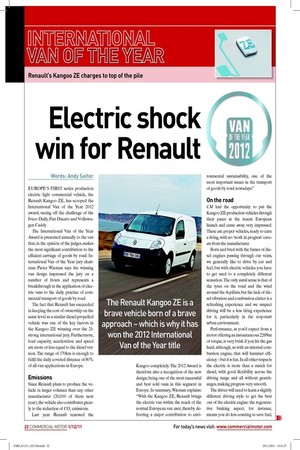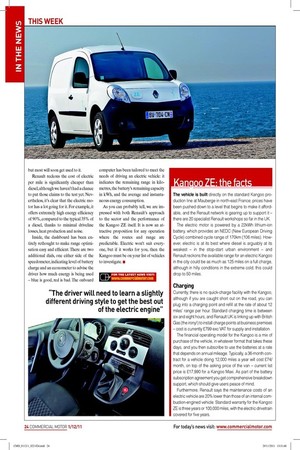Electric shock win for Renault
Page 15

Page 16

If you've noticed an error in this article please click here to report it so we can fix it.
Words: Andy Salter
EUROPE’S FIRST series production electric light commercial vehicle, the Renault Kangoo ZE, has scooped the International Van of the Year 2012 award, seeing off the challenge of the Iveco Daily, Fiat Ducato and Volkswagen Caddy.
The International Van of the Year Award is presented annually to the van that, in the opinion of the judges, makes the most signiicant contribution to the eficient carriage of goods by road. International Van of the Year jury chairman Pieter Wieman says the winning van design impressed the jury on a number of fronts and represents a breakthrough in the application of electric vans to the daily practice of commercial transport of goods by road.
The fact that Renault has succeeded in keeping the cost of ownership on the same level as a similar diesel-propelled vehicle was one of the key factors in the Kangoo ZE winning over the 21strong international jury. Furthermore, load capacity, acceleration and speed are more or less equal to the diesel version. The range of 170km is enough to fulil the daily covered distance of 80% of all van applications in Europe.
Emissions
Since Renault plans to produce the vehicle in larger volumes than any other manufacturer (20,000 of them next year), the vehicle also contributes greatly to the reduction of CO2 emissions.
Last year Renault renewed the Kangoo completely. The 2012 Award is therefore also a recognition of the new design, being one of the most successful and best sold vans in this segment in Europe. In summary, Wieman explains: “With the Kangoo ZE, Renault brings the electric van within the reach of the normal European van user, thereby delivering a major contribution to envi ronmental sustainability, one of the most important issues in the transport of goods by road nowadays.”
On the road
CM had the opportunity to put the Kangoo ZE production vehicles through their paces at the recent European launch and came away very impressed. These are proper vehicles, ready to earn a living, with no ‘work in progress’ caveats from the manufacturer.
Born and bred with the fumes of diesel engines passing through our veins, we generally like to drive by ear and feel, but with electric vehicles you have to get used to a completely different sensation. The only aural sense is that of the tyres on the road and the wind around the A-pillars, but the lack of diesel vibration and combustion clatter is a refreshing experience and we suspect driving will be a less tiring experience for it, particularly in the stop-start urban environment.
Performance, as you’d expect from a motor offering an instantaneous 226Nm of torque, is very brisk if you hit the gas hard, although, as with an internal combustion engine, that will hammer eficiency – but it is fun. In all other respects the electric is more than a match for diesel, with good lexibility across the driving range and all without gearchanges, making progress very smooth.
The driver will need to learn a slightly different driving style to get the best out of the electric engine: the regenerative braking aspect, for instance, means you do less coasting to save fuel, but most will soon get used to it.
Renault reckons the cost of electric per mile is signiicantly cheaper than diesel, although we haven’t had a chance to put those claims to the test yet. Nevertheless, it’s clear that the electric motor has a lot going for it. For example, it offers extremely high energy eficiency of 90%, compared to the typical 35% of a diesel, thanks to minimal driveline losses, heat production and noise.
Inside, the dashboard has been entirely rethought to make range optimisation easy and eficient. There are two additional dials, one either side of the speedometer, indicating level of battery charge and an econometer to advise the driver how much energy is being used – blue is good, red is bad. The onboard computer has been tailored to meet the needs of driving an electric vehicle: it indicates the remaining range in kilometres, the battery’s remaining capacity in kWh, and the average and instantaneous energy consumption.
As you can probably tell, we are impressed with both Renault’s approach to the sector and the performance of the Kangoo ZE itself. It is now an attractive proposition for any operation where the routes and range are predictable. Electric won’t suit everyone, but if it works for you, then the Kangoo must be on your list of vehicles to investigate. ■











































